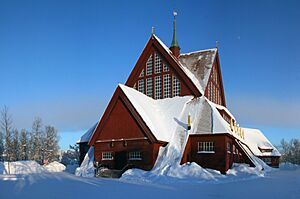Kiruna Church facts for kids
Quick facts for kids Kiruna Church |
|
|---|---|

Kiruna Church in 2011
|
|
| 67°51′7.2″N 20°13′58.7″E / 67.852000°N 20.232972°E | |
| Location | Kiruna |
| Country | Sweden |
| Denomination | Church of Sweden |
| History | |
| Consecrated | 8 December 1912 |
| Administration | |
| Parish | Jukkasjärvi |
| Diocese | Luleå |
Kiruna Church (in Swedish: Kiruna kyrka) is a special church building located in Kiruna, Sweden. It is one of the largest buildings in Sweden made almost entirely of wood. The church was built between 1909 and 1912. It was designed by an architect named Gustaf Wickman. The outside of the church looks like a Gothic Revival building, which means it has a style similar to old European cathedrals. However, the main artwork inside, the altarpiece, is in a more modern style called Art Nouveau.
Contents
History of Kiruna Church
The Kiruna Church was built from 1909 to 1912. It was officially opened on December 8, 1912, by Bishop Olof Bergqvist. Since 1913, it has been part of the Jukkasjärvi parish in the Luleå diocese. Gustaf Wickman was the architect who designed the church. The famous altarpiece, which is a large painting behind the altar, was created by Prince Eugen, Duke of Närke.
Gustaf Wickman moved to Kiruna in 1899. He was asked by Hjalmar Lundbohm to design the church and the town. Lundbohm was the manager of the LKAB mining company and helped start the community. The mining company mostly paid for the church to be built. Lundbohm wanted everyone to feel welcome in the church. So, he decided not to use too many Christian symbols. Bishop Olof Bergqvist, however, wanted the church to clearly show its Christian connection. As a compromise, the Swedish sculptor Christian Eriksson made just one cross for the whole building.
In 2001, Kiruna Church was voted the most popular building in Sweden built before 1950. This was in a national survey by the Swedish Travelling Exhibitions. Many people think of it as "the Shrine of the Nomadic people."
Because the Kiruna Mine is expanding, the church needs to be moved. It is planned to be moved to a new spot next to the cemetery in 2025 or 2026. This is a huge project to protect this important building.
Design of the Church Building
Kiruna Church is one of Sweden's biggest wooden buildings. Its design was greatly inspired by traditional Sami huts and old Norwegian stave churches. The outside of the building looks like a neo-Gothic style. The inside has elements of national romanticism, which is a style that celebrates national history and nature. The altarpiece is in the Art Nouveau style. The church's overall shape uses simple geometric forms. It has an open and spacious square design with tall, balanced triangular shapes.
Outside Features
The church's roof is very large and almost reaches the ground. It is covered with many wooden shingles, making it hard to tell where the roof ends and the walls begin. This style is called Shingle Style. It shows what was possible with wood construction at the time. There are twelve golden bronze figures on the roof. These were sculpted by Christian Eriksson. Each sculpture shows a different human emotion.
Inside Features
Kiruna Church has a main central area called a nave. It also has two smaller areas on the sides, known as side naves. These areas have beautifully designed dormers, which are windows that stick out from the roof. The main part of the church has large windows that let in a lot of natural light. However, the lower parts of the side aisles have colored glass. This creates a darker, more peaceful feeling in those areas. The detailed woodwork and carved latticework in the choir area were influenced by Sami decorations. Christian Eriksson also made wooden sculptures that stand freely inside the church.
The altarpiece, called "The Holy Grove," was created by Prince Eugen. It is the main artwork inside the church. This large painting shows a wide, endless landscape.
Bell Tower
The bell tower was built even before the church itself, between 1906 and 1907. It stands about 20 meters west of the church building. The tower's design was influenced by other bell towers in northern Sweden. It uses the same materials and colors as Kiruna Church.


